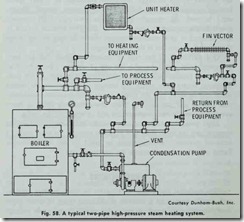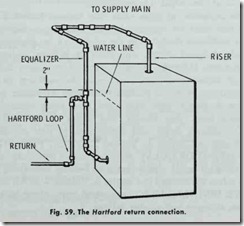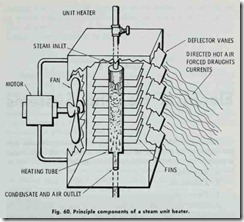HIGH PRESSURE STEAM HEATING SYSTEMS
High pressure steam heating systems operate at pressures above 15 psig (generally in the 25 psig to 150 psig range), and are usually found in large industrial buildings in which space heating or steam process equipment (e.g. water heaters, dryers, etc.) is used. An example of a typical two-pipe high pressure steam heating system is shown in Fig. 58. This type of system is also referred to as a medium pressure steam heating system when the steam pressures are in the lower ranges.
One advantage of this type of heating system is that the high pressure of the steam permits the use of smaller pipe sizes. The high steam pressure also makes possible the elevation of the con densation return lines above the heating units, because the return water can be lifted into the return mains. High pressure condensa tion pumps and thermostatic traps are commonly used in these systems to handle the condensation and return it to the boiler.
High pressure steam heating systems are more expensive to operate and maintain than low pressure systems. In most cases, a licensed stationary engineer must be hired for the installation; a factor which tends to increase the operating cost.
STEAM BOILERS
The boiler is the source of heat for a steam heating system, and it will operate on a number of different types of fuels; how ever, regardless of the fuel used, the operating principle will be the same. Water is heated until it boils and changes to steam. The steam is then distributed to the heat emitting units throughout the structure either by natural or mechanical means .
Low pressure steam heating boilers are used in residences and small buildings. The design and construction of these boilers is very similar to the boilers used in hot-water heating systems in the same size structure. Both types of boilers are described in considerable detail in Chapter 15 (BOILERS AND BOILER FITTINGS).
CONTROL COMPONENTS
The controls used ·to regulate steam boilers and to insure their safe and efficient operation, are similar in most respects to those used with hot water boilers. A list of the principal controls used with steam boilers would include:
1. ASME safety valve,
2. Steam pressure gauge,
3. Low-water cutoff,
4. Boiler water feeder,
5. High-limit pressure control,
6. Water gauge glass,
7. Water cocks,
8. Primary control (burner mounted),
9. Operating control (with tankless heater).
These and other types of boiler controls are described in considerable detail in Chapter 15 (BOILERS AND BOILER FITTINGS); Chapter 4, Volume 2 (THERMOSTATS AND HUMIDISTATS); and Chapter 9, Volume 2 {VALVES AND VALVE INTALLATION).
HARTFORD RETURN CONNECTION
A well designed steam heating system will have a Hartford return connection (Fig. 59) in the condensation return line. The purpose of the Hartford return connection (or Hartford loop, as it is sometimes called) is to prevent excessive loss of water from the boiler when a break-down (such as a water leak) occurs in the return line.
As shown in Fig. 59, an equalizer connects the lower outlet to the steam outlet. The Hartford connection is taken off from the equalizer an inch or two below the normal water level. Evidently low pressure can only draw water out of the boiler connection. This gives a low water level and it cannot recede further because steam will flow into the connection leg as the water recedes in the leg due to pressure difference.
More details about different types of boiler connections are found in Chapter 15 (BOILERS AND BOILER FITTINGS) and in Chapter 9, Volume 2.
PIPES AND PIPING DETAILS
A steam heating system requires careful planning of the piping to insure both an efficient and a safe operation. For example, the type of pipe material used (e.g. wrought iron, Schedule-40 black steel, etc.) is important, because the capacity of a particular weight pipe will depend on both its size and the material from which it is constructed.
The expansion of pipes when they become heated is another factor that must be considered when designing a steam heating system. Sufficient flexibiHty in the piping can be provided for by correctly designed offsets, slip joints or bellows, radiators and riser runouts, U-bends, or other types of expansion loops. The pitch of connections from risers must be sufficient to prevent the formation of water pockets when pipe expansion occurs.
Pipe materials, pipe sizes (and pipe sizing methods), pipe expansion rates, pipe fittings, and piping details such as wet and dry returns, drips, and connections to heat emitting units are covered in Chapter 8, Volume 2 (PIPES, PIPE FITTINGS AND PIPING DETAILS). Although valves and steam traps are often included under piping details by heating authorities, the ma ingly , valves are covered in Chapter 9, Volume 2 (VALVES AND VALVE INSTALLATION) and steam traps, along with pumps, siphons, strainers and similar devices.
STEAM TRAPS
A steam trap is an automatic device installed in a steam line to control the flow of steam, air, and condensation. In oper ation, it opens to expel air and condensation, and closes to prevent the escape of steam. All steam traps operate on the prin ciple that the pressure within the trap at the time of discharge will be slightly in excess of the pressure against which the trap must discharge.
The principal functions of steam traps in steam heating systems include: ( 1) draining condensation from the piping system, radiators, and steam processing equipment; (2) return ing condensation to the boiler; (3) lifting condensation to a higher elevation in the heating system; and ( 4) handling con densation from one pressure to another.
Steam traps may be classified on the basis of their operating principles as follows:
1. Float traps,
2. Bucket traps,
3. Thermostatic traps,
4. Float and thermos·tatic traps,
5. Flash traps,
6. Impulse traps,
7. Lifting traps,
8. Boiler return traps.
PUMPS
Pumps are used in steam heating systems to dispose of the condensation or return H to the boiler, and to discharge excess air and noncondensable gases to the atmosphere. The specific function (or functions) of a pump will depend on the type of steam heating system in which it is used. The two basic types of steam heating pumps are:
1. Condensation return pumps.
2. Vacuum heating pumps.
HEAT EMITTING UNITS
A heat emitting unit is a device which transmits heat to the interior of a room or space. The two types of heat emitting units used in steam heating systems are radiators and convectors. Simply defined, a radiator is a heat emitting unit which transmits heat from a direct heating surface principally by means of radia ·tion. A convector, on the other hand, may be defined as a heat emitting unit which transmits heat from a heating surface princi pally by means of convection. The heating surface of a convector is usually of the extended finned tube construction.
A detailed description of the heat emitting units used in steam heating systems is contained in Chapter 2, Volume 3 (RADIA
TORS, CONVECTORS AND UNIT HEATERS).
AIR SUPPLY AND VENTING
Two types of venting occur in heating systems. One type deals with the passing to the outdoors of smoke and gases resulting from the burning of combustible fuels (e.g. coal, oil, and gas), and is described in the various chapters on furnaces and boilers. Another type of venting deals with the relief of pressure in steam heating systems by allowing a certain amount of air to escape (i.e. be vented) from the radiators. Venting radiators is described in Chapter 2, Volume 3 (RADIATORS, CONVECTORS AND UNIT HEATERS).
UNIT HEATERS
A unit heater is essentially a forced draft convector. A cen trifugal fan or propeller is used to force the air over the heating surface and into the room or space through deflector vanes. The principal operating components of a steam unit heater are shown in Fig. 60. Unit heaters find their widest application in industrial and commercial buildings, gymnasiums, field houses, auditoriums, and other types of large buildings.
All types of unit heaters are described in considerable detail in Chapter 2, Volume 3 (RADIATORS, CONVECTORS AND UNIT HEATERS).
AIR CONDITIONING
Central air conditioning can be added to a s,team heated struc ture by installing a water chiller or a separate forced air cooling system (i.e. a split system).
The water chiller and steam boiler may be installed as separate units, or a complete package containing both units may be used. Water chiller installations are very rarely used in residential air conditioning. Split system air conditioning dominates this field with respect to steam heated residences).


